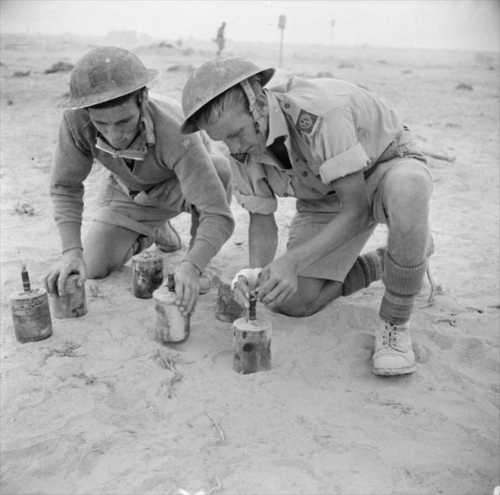
British Forces
Tricky work - defusing S-Mines.
H.M. Government.
Sappers of the Highland Division practice defusing German S-Mines, North Africa. The S-Mine (Schrapnellmine, or Sprigmine) was introduced by the Germans in 1935, and first encountered by the Allies in the course of French "probing" operations into German territory, spring 1940. It was a nasty piece of work. In the canister was a main charge of trinitrotoluene (TNT), surrounded by a "jacket" of large shot, all of this resting on a charge of black powder (old-fashioned gunpowder). Down the centre of the cylinder ran a two-stage fuse mechanism attached to a pressure trigger at the top of the column. The mine could be set to explode either on the exertion of pressure on the "tip" of the fuse column, or by means of a trip wire or tension wire attached to the filaments in the top of the fuse column. When the mine was triggered, a short delay (3-4 seconds) allowed the unfortunate triggerer to step away from the device (usually without having noticed that he had triggered anything). The first stage of the fusing mechanism would then ignite the black powder charge at the bottom, which would launch the device 3 to 4 feet into the air; then, the secondary fuse would explode the main TNT charge, launching the shrapnel/shot into any body of enemy troops in the vicinity. The object was, not so much to kill enemy soldiers (although it could) but to wound and disable them; wounds to the legs, lower abdomen and genitals were common, and wounded comrades would have been much more of a burden to the enemy troops than dead ones. This weapon was made with metal, and so was detectible with metal detectors. However, these were seldom available when the problem arose, and attacking troops who feared the presence of S-Mines usually had to probe for them with knives, inserted in the ground at a shallow angle, very carefully. Once found, the device could usually be rendered (relatively) harmless fairly easily by replacing the safety pin and unscrewing the fuse column from the body of the mine. This seems to be what is being practiced here. I would not have fancied the job. A slightly more advanced replacement for the original S-35 mine - the S-44 - was being phased in in 1944. It was essentially similar to the S-35, but had an offset fuse column. The "springing mine" was considered a formidable and fearsome anti-personnel defense weapon by both Germans and Allies, and was widely copied at the time and since. Best regards, JR.
2702 Views
2/11/2015
